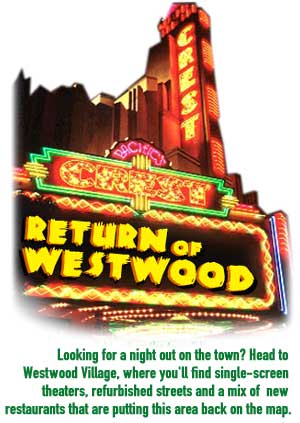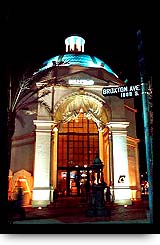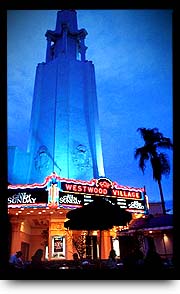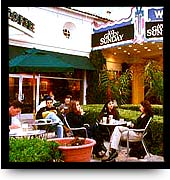WESTWOOD - Tired of the malls? Miffed
by megaplexes that charge $9 to watch a movie on a screen not much bigger than
the TV in your living room?
Maybe it's time to get over to the Westwood, where the movie screens are big,
the theaters roomy, and there's always a place to grab a bite nearby. This once
popular, 2.5 mile village on the South end of the UCLA Campus is undergoing a
much needed makeover.
Renovations, refurbishment and an influx of new restaurants are smoothing away
a decade of deterioration while leaving one of its main attractions intact: single-screen
movie theaters. Sure, it's not as popular as the Promenade, but you'll find the
restaurants pleasantly crowded, the movie theaters busy and sidewalks populated
by people out for a night on the town.
 Westwood Village was developed in
the late 1920s as a small town within a city by Janss Investment, which also helped
develop the Westwood area. The design was a unifying Spanish Colonial look of
three story height. It became a center for arts and entertainment in the 1930s.
Westwood Village was developed in
the late 1920s as a small town within a city by Janss Investment, which also helped
develop the Westwood area. The design was a unifying Spanish Colonial look of
three story height. It became a center for arts and entertainment in the 1930s.
But the Village reached the height of its fame during the 1980s. Then, streets
were filled with throngs of people who flocked to restaurants and stores, attended
UCLA activities and, of course, flocked to the latest film releases. That ended
in the late '80s after gang activity and the murder of an innocent bystander scared
crowds away. The violence was the topper to an area already fraught with problems.
Parking was -- and still can be -- difficult. And newer entertainment centers
such as Santa Monica's Third Street Promenade and the revitalized Old Town Pasadena
lured people away.
 Upscale
eateries such as Eurochow are adding to Westwood's appeal.
Upscale
eateries such as Eurochow are adding to Westwood's appeal.
Today restaurateurs, hospitality companies, real estate developers and art institutions
are working for a return to Westwood's popularity. Investments topping $200 million
have been poured into restaurants, hotels, arts centers and the renovation of
old buildings.
But one of Westwood Village's chief attractions remains its abundance of first-run,
single-screen movie theaters. Some have been restored to their former glory, while
others await their future.
Locals once saw the proliferation of theaters as the beginning of the end of Westwood's
quaint village feel. Ironically, in a millennium of multiplexes, the single-screen
theaters now help maintain that small-town atmosphere.
There are five single-screen theaters located north of Wilshire Boulevard in Westwood
Village, and each has a character all its own.
A beautiful art deco venue, the Crest has been
restored to its original luster. First built for stage shows, the interior is
a show in itself. Every inch of the theater's walls is covered by old-style Hollywood
cityscapes, complete with searchlights. The ceiling has star-like lights, the
seats are velvety with firm backs, and the closed curtain's astrological art is
a sight to behold. From the outside, the neon marquee is an eye-catcher in itself.
"Typically, single-screen theaters don't survive in many areas and, in that way,
Westwood's unique," says Rimas Tumas, director of construction for Mann Theaters.
Tumas believes the reason the Mann chain has kept them is that they are landmark
theaters. "Also, they're all very close. It's an easy walk between," he says.
 Built
in 1931, the Village Theater remains one of the largest and most luxurious movie
venues in Westwood.
Built
in 1931, the Village Theater remains one of the largest and most luxurious movie
venues in Westwood.
The first movie theater built in Westwood was the Fox Village. Designed in 1931
by a man named P.P. Lewis, the Village is representative of the architecture of
the time. When the theater opened its doors, tickets sold for a mere 50 cents.
Since then, hundreds of blockbuster films have premiered there. The theater features
white, searchlight-style architecture and room inside for 1,400 people.
There's a high balcony, gold-leaf reliefs on the walls, multiple archways in the
lobby, velvet curtains, a tromp l'oeil ceiling and sofas in the restrooms.
Today, it is favored by movie studios and many famous Angelenos. George Lucas
likes to test new technology there. Movie theater employees cite Calista Flockhart,
Adam Sandler, and many a Lakers player among the elite who often pay the $9 admission
fee.
Directly across the street from Village Theater sits the Mann. This 660-seat theater
was also built in 1931. Inside you'll find comfortable seats and likely a Hollywood
blockbuster on the screen. It has the same amenities as the Village, and premieres
take place here, too. But architecturally it can't compete with its twice-as-large,
twice-as-spectacular neighbor across the street.
The third-largest theater in Westwood, the Mann National, sports a large glass-windowed
lobby, a vast screening room and comfortable seats. It hosts its share of premieres
and press screenings, and there's always a line around the corner for blockbuster
films on opening weekends. The furniture and carpet are old and fraying, but the
screen is big, the sound is good, and the armrests have soda-cup holders. According
to Dimas, the theater chain has no plans to refurbish or remodel the National,
or any of the other theaters, with the exception of regular repairs.
 The
Crest Theater features a flashy neon marquee.
The
Crest Theater features a flashy neon marquee.
The most recently renovated of the single-screen theaters in Westwood is the Festival.
Located on the corner of Westwood Boulevard and Lindbrook Avenue, this 564-seat
venue also has a small balcony. Several months ago, Mann refurbished the inside,
adding more comfortable, modern chairs and amenities.
But with all the renovations going on around them the final single-screen theaters
-- the Mann Regent and -- look and feel a bit shabby. The seats are older and
less comfortable, and first-run films usually start at one of the larger screens
in the area before moving to these locations.
Presently the future of the single-screen theaters is unknown. Mann Theaters,
the company that owns them, has just been purchased from WestStar Cinemas by WF
Cinema Holdings L.P., a joint venture of Viacom Inc. and Warner Bros. after WestStar
filed for bankruptcy.
Barbara Brogliatti, Sr. Vice President of Corporate Communications for Warner
Bros., refused to speculate about the future of the Westwood Village theaters,
saying that the company is exploring all of its options.

Starbucks provides an outdoor cafe setting adjacent to the Village Theater.
As for the Village, there is more development on the horizon. In addition to rumors
of a Gelson's grocery store and imminent announcements of retail tenants, there
is talk of leveling the current Mann fourplex to make way for a new cineplex.
A new state of the art theater at the Armand Hammer Museum for the UCLA Film and
Television Archives is due to be completed by September 2001. The theater also
will include a bookstore, coffee shop and additional parking.
Westwood Village -- where you can still enjoy the large single movie screens and
small crowds, while they last.
[Editor's Note: Laura Flores, Jerome Adamstein, and Shayna Sobol also contributed
to this Feature.]





